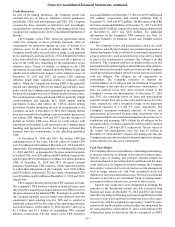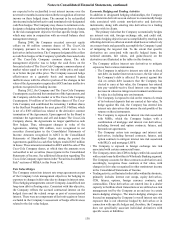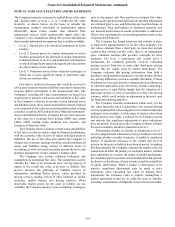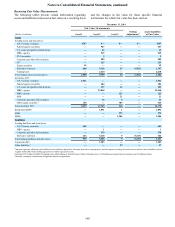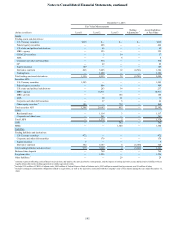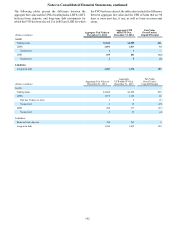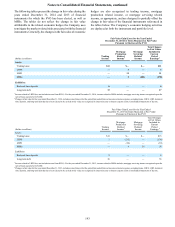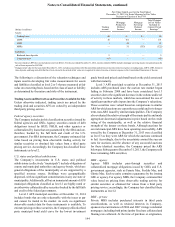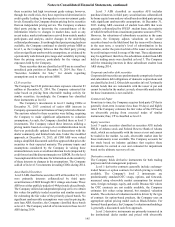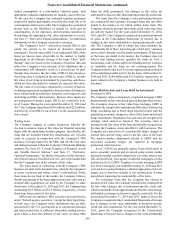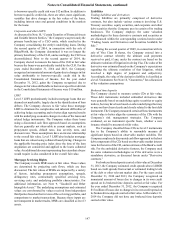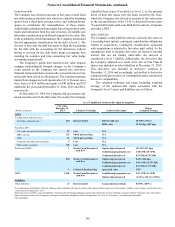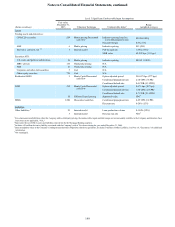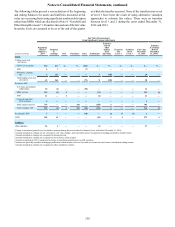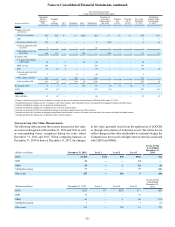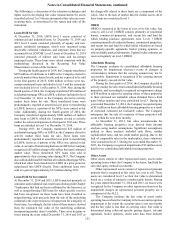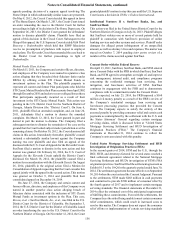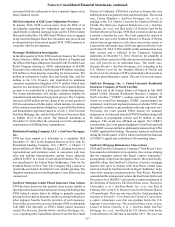SunTrust 2014 Annual Report Download - page 170
Download and view the complete annual report
Please find page 170 of the 2014 SunTrust annual report below. You can navigate through the pages in the report by either clicking on the pages listed below, or by using the keyword search tool below to find specific information within the annual report.Notes to Consolidated Financial Statements, continued
147
to borrower-specific credit risk were $12 million. In addition to
borrower-specific credit risk, there are other, more significant,
variables that drive changes in the fair values of the loans,
including interest rates and general conditions in the markets
for the loans.
Corporate and other LHFS
As discussed in Note 10, “Certain Transfers of Financial Assets
and Variable Interest Entities,” the Company was previously the
primary beneficiary of a CLO entity, which resulted in the
Company consolidating the entity's underlying loans. During
the second quarter of 2014, in connection with the sale of
RidgeWorth, the Company determined it was no longer the
primary beneficiary of the CLO, and accordingly, the CLO was
deconsolidated. Prior to the second quarter of 2014, the
Company elected to measure the loans of the CLO at fair value
because the loans were periodically traded by the CLO. For the
years ended December 31, 2014 and 2013, the Company
recognized an immaterial amount of gains due to changes in fair
value attributable to borrower-specific credit risk in the
Consolidated Statements of Income. For the year ended
December 31, 2012, gains the Company recognized due to
changes in fair value attributable to borrower-specific credit risk
in the Consolidated Statements of Income were $10 million.
LHFI
Level 3 LHFI predominantly includes mortgage loans that are
deemed not marketable, largely due to the identification of loan
defects. The Company chooses to fair value these mortgage
LHFI to eliminate the complexities and inherent difficulties of
achieving hedge accounting and to better align reported results
with the underlying economic changes in value of the loans and
related hedge instruments. The Company values these loans
using a discounted cash flow approach based on assumptions
that are generally not observable in current markets, such as
prepayment speeds, default rates, loss severity rates, and
discount rates. These assumptions have an inverse relationship
to the overall fair value. Level 3 LHFI also includes mortgage
loans that are valued using collateral based pricing. Changes in
the applicable housing price index since the time of the loan
origination are considered and applied to the loan's collateral
value. An additional discount representing the return that a buyer
would require is also considered in the overall fair value.
Mortgage Servicing Rights
The Company records MSR assets at fair value. These values
are determined by projecting cash flows, which are then
discounted. The fair values of MSRs are impacted by a variety
of factors, including prepayment assumptions, spreads,
delinquency rates, contractually specified servicing fees,
servicing costs, and underlying portfolio characteristics. For
additional information, see Note 9, "Goodwill and Other
Intangible Assets." The underlying assumptions and estimated
values are corroborated by values received from independent
third parties based on their review of the servicing portfolio, and
comparisons to market transactions. Because these inputs are
not transparent in market trades, MSRs are classified as level 3
assets.
Liabilities
Trading liabilities and derivatives
Trading liabilities are primarily comprised of derivative
contracts, but also include various contracts involving U.S.
Treasury securities, equity securities, and corporate and other
debt securities that the Company uses in certain of its trading
businesses. The Company employs the same valuation
methodologies for these derivative contracts and securities as
are discussed within the corresponding sections herein under
“Trading Assets and Derivatives and Securities Available for
Sale.”
During the second quarter of 2009, in connection with its
sale of Visa Class B shares, the Company entered into a
derivative contract whereby the ultimate cash payments
received or paid, if any, under the contract are based on the
ultimate resolution of litigation involving Visa. The value of the
derivative was estimated based on the Company’s expectations
regarding the ultimate resolution of that litigation, which
involved a high degree of judgment and subjectivity.
Accordingly, the value of the derivative liability is classified as
a level 3 instrument. See Note 16, "Guarantees," for a discussion
of the valuation assumptions.
Brokered time deposits
The Company elected to measure certain CDs at fair value.
These debt instruments included embedded derivatives that
were generally based on underlying equity securities or equity
indices, but may have been based on other underlyings that may
or may not have been clearly and closely related to the host debt
instrument. The Company measured certain of these instruments
at fair value to better align the economics of the CDs with the
Company’s risk management strategies. The Company
evaluated, on an instrument specific basis, whether a new
issuance should be measured at fair value.
The Company classified these CDs as level 2 instruments
due to the Company’s ability to reasonably measure all
significant inputs based on observable market variables. The
Company employed a discounted cash flow approach to the host
debt component of the CD, based on observable market interest
rates for the term of the CD, and an estimate of the Bank’s credit
risk. For the embedded derivative features, the Company used
the same valuation methodologies as if the derivative were a
standalone derivative, as discussed herein under “Derivative
contracts.”
For brokered time deposits carried at fair value at December
31, 2013, the Company estimated credit spreads above LIBOR
based on credit spreads from actual or estimated trading levels
of the debt or other relevant market data. For the years ended
December 31, 2014 and 2013, the Company recognized an
immaterial amount of losses due to changes in its own credit
spread on its brokered time deposits carried at fair value. For
the year ended December 31, 2012, the Company recognized
$15 million of losses due to changes in its own credit spread on
its brokered time deposits carried at fair value. At December 31,
2014 the Company did not have any brokered time deposits
carried at fair value.


